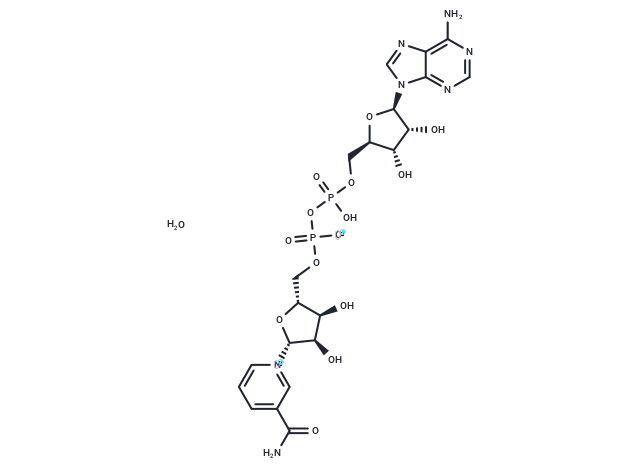Shopping Cart
- Remove All
 Your shopping cart is currently empty
Your shopping cart is currently empty

NAD+ (β-Nicotinamide Adenine Dinucleotide) is a coenzyme composed of ribosylnicotinamide 5'-diphosphate coupled to adenosine 5'-phosphate by pyrophosphate linkage. It is found widely in nature and is involved in numerous enzymatic reactions in which it serves as an electron carrier by being alternately oxidized (NAD+) and reduced (NADH).

| Pack Size | Price | Availability | Quantity |
|---|---|---|---|
| 500 mg | $41 | In Stock | |
| 1 g | $48 | In Stock |
| Description | NAD+ (β-Nicotinamide Adenine Dinucleotide) is a coenzyme composed of ribosylnicotinamide 5'-diphosphate coupled to adenosine 5'-phosphate by pyrophosphate linkage. It is found widely in nature and is involved in numerous enzymatic reactions in which it serves as an electron carrier by being alternately oxidized (NAD+) and reduced (NADH). |
| In vitro | METHODS: HEK293 cells were treated with FK866 (2 µM) and NAD+ (100 µM) for 48 h. Metabolic activity was determined by MTT Assay. RESULTS: Addition of FK866 to the culture medium resulted in rapid depletion of intracellular NAD stores and inhibition of the metabolic activity of NADPH-dependent dehydrogenase. When supplemented with additional NAD+, the metabolic activity of the cells returned to control levels. [1] METHODS: Isolated microvessels from rat retina were treated with NAD+ (0-1000 nM) for 0-24 h. Cell death was detected using trypan blue dye. RESULTS: Exposure to NAD+ increased microvascular cell death in a dose-dependent manner, with the half-maximum effective concentration of NAD+ being approximately 2 nM. assessment of the time course of NAD+-induced vascular toxicity showed that cell death was detected after 16 h of NAD+ exposure. [2] |
| In vivo | METHODS: To study the effects on ischemia/reperfusion (I/R) injury, NAD+ (5-20 mg/kg) was injected intravenously into Wistar rats with myocardial ischemia/reperfusion. RESULTS: Injections of 10-20 mg/kg NAD+ dose-dependently reduced I/R-induced myocardial infarction, with a dose of 20 mg/kg NAD+ reducing infarction by approximately 85%. Injection of NAD+ significantly reduced I/R-induced apoptotic cardiac injury. [3] |
| Alias | β-Nicotinamide Adenine Dinucleotide, β-NAD, β-DPN, DPN, Cozymase |
| Molecular Weight | 663.43 |
| Formula | C21H27N7O14P2 |
| Cas No. | 53-84-9 |
| Smiles | O.NC(=O)c1ccc[n+](c1)[C@@H]1O[C@H](COP([O-])(=O)OP(O)(=O)OC[C@H]2O[C@H]([C@H](O)[C@@H]2O)n2cnc3c(N)ncnc23)[C@@H](O)[C@H]1O |
| Relative Density. | Ca. 1.6 g/cm3. Temperature:20 °C. |
| Storage | store at low temperature,keep away from direct sunlight,store under nitrogen | Powder: -20°C for 3 years | In solvent: -80°C for 1 year | Shipping with blue ice. |
| Solubility Information | 5% DMSO+95% Saline: 0.33 mg/mL (0.5 mM), In vivo: Please add co-solvents sequentially, clarifying the solution as much as possible before adding the next one. Dissolve by heating and/or sonication if necessary. Working solution is recommended to be prepared and used immediately. H2O: 40 mg/mL (60.29 mM ), Sonication is recommended. |

Copyright © 2015-2025 TargetMol Chemicals Inc. All Rights Reserved.